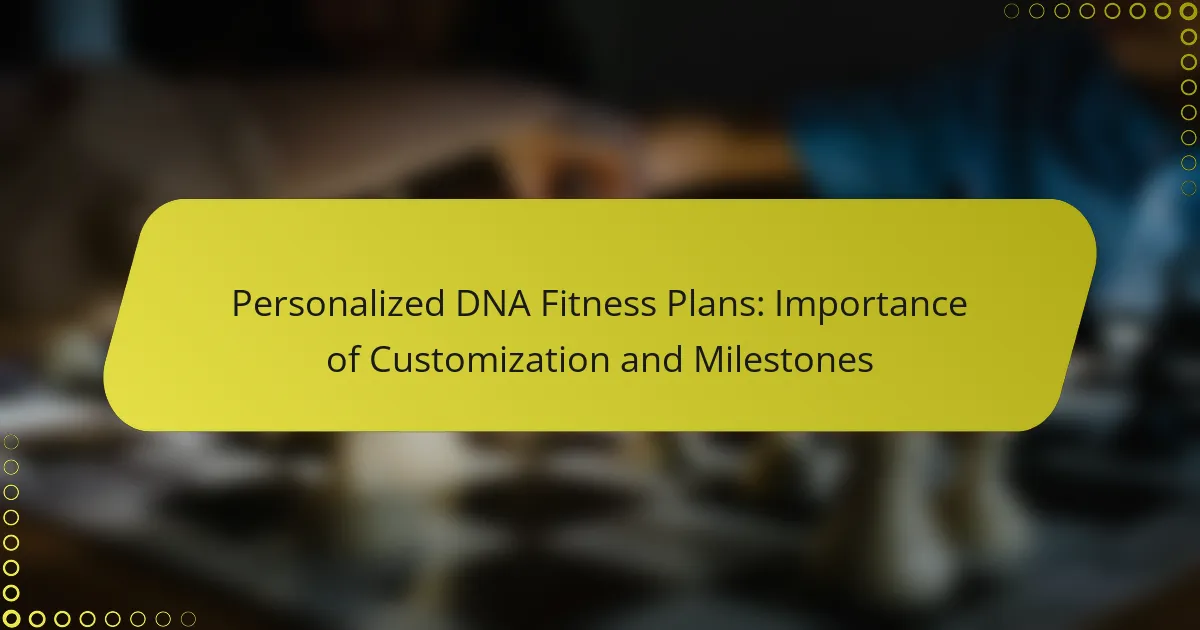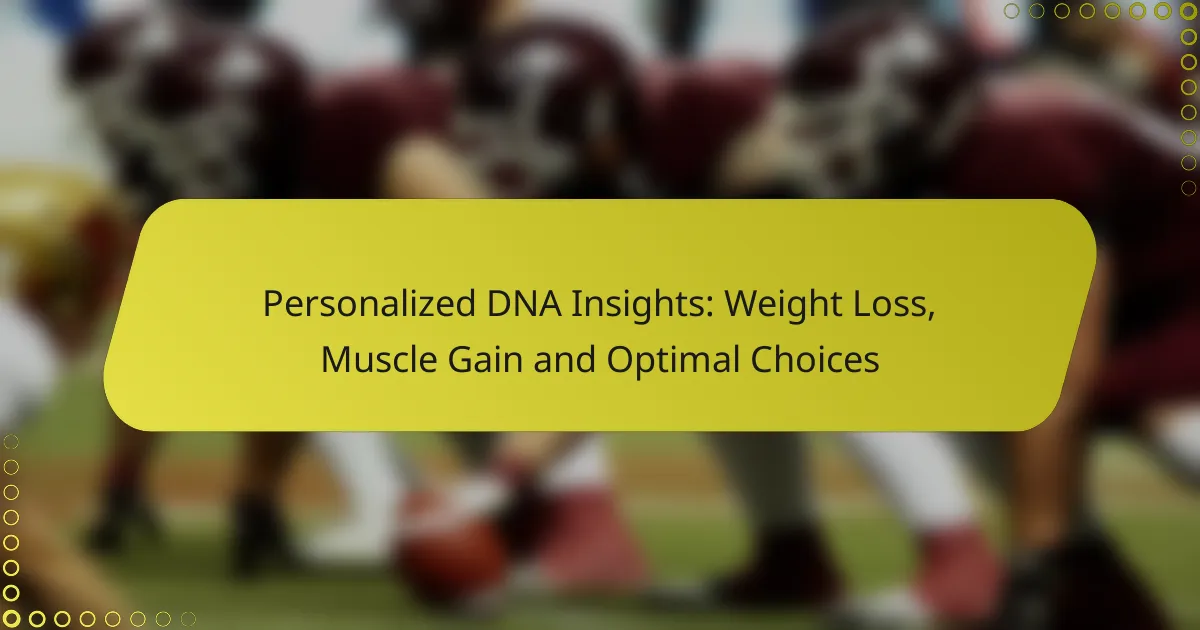Genetic data plays a crucial role in enhancing fitness tracking by offering personalized insights based on individual genetic profiles. By analyzing DNA samples, users can receive tailored recommendations for optimizing their workout routines, nutrition, and recovery strategies, ultimately improving their overall performance. Understanding these genetic markers allows for the development of customized fitness plans that align with personal strengths and areas for growth.
![]()
How Can Genetic Data Improve Fitness Tracking?
Genetic data can significantly enhance fitness tracking by providing insights tailored to individual genetic profiles. This information helps users optimize their workout routines, recovery strategies, nutrition, and overall performance.
Personalized workout plans
Genetic data can inform personalized workout plans by identifying the most effective types of exercise for an individual. For example, some people may respond better to endurance training, while others may excel with strength training. Utilizing this information can lead to more efficient workouts and better results.
When creating a personalized plan, consider factors such as muscle fiber composition and aerobic capacity. These insights can help tailor the intensity, duration, and frequency of workouts to align with genetic predispositions.
Enhanced recovery strategies
Understanding genetic factors can lead to enhanced recovery strategies, allowing individuals to recover more effectively after workouts. Certain genetic markers may indicate how quickly one can recover from intense exercise or how prone they are to muscle soreness.
Incorporating recovery techniques that align with genetic insights, such as specific stretching routines or rest periods, can help optimize recovery time. For instance, if genetic data suggests a slower recovery rate, longer rest periods or active recovery days may be beneficial.
Optimized nutrition recommendations
Genetic data can guide optimized nutrition recommendations tailored to an individual’s metabolic responses. Certain genes influence how the body processes macronutrients, which can affect dietary choices for better performance and recovery.
For example, individuals with a genetic predisposition for faster carbohydrate metabolism may benefit from higher carbohydrate intake, while those who metabolize fats more efficiently might thrive on a higher-fat diet. Understanding these nuances can help in crafting a diet that supports fitness goals.
Injury risk assessment
Genetic data can play a crucial role in injury risk assessment by identifying predispositions to certain injuries. Some individuals may have genetic markers associated with weaker connective tissues or slower healing processes, which can inform training decisions.
By understanding these risks, athletes can implement preventive measures, such as targeted strength training or flexibility exercises, to mitigate the likelihood of injuries. Regular assessments and adjustments based on genetic insights can further enhance safety during training.
Performance prediction
Genetic data can aid in performance prediction by revealing potential athletic capabilities and limitations. Certain genetic markers are linked to endurance, strength, and speed, providing a clearer picture of what an individual might achieve in various sports.
Using this information, athletes can set realistic performance goals and focus on areas where they are genetically predisposed to excel. This targeted approach can lead to improved motivation and better training outcomes.

What Tools Are Available for Genetic Fitness Analysis?
Several tools are available for genetic fitness analysis, each offering unique insights into how your genetic makeup can influence your fitness journey. These tools typically analyze DNA samples to provide personalized recommendations for diet, exercise, and overall wellness.
23andMe
23andMe is a popular genetic testing service that provides health and ancestry reports based on your DNA. The health reports include information on genetic traits, carrier status for certain conditions, and wellness insights that can help you tailor your fitness and nutrition plans.
When using 23andMe, consider that the health-related reports are based on genetic variants that may not be definitive indicators of health outcomes. It’s advisable to consult with a healthcare professional for personalized advice based on your results.
DNAfit
DNAfit specializes in fitness and nutrition insights derived from genetic data. Their analysis focuses on how your genes may affect your response to different types of exercise, recovery times, and dietary needs. This can help you create a more effective fitness regimen tailored to your genetic profile.
DNAfit offers various reports, including fitness, nutrition, and wellness. Users should be aware that while genetic predispositions can guide choices, lifestyle factors also play a crucial role in achieving fitness goals.
MyHeritage DNA
MyHeritage DNA primarily focuses on ancestry but also provides health reports that can inform fitness decisions. Their service analyzes genetic markers associated with various health conditions and traits, which can help you understand potential health risks related to fitness.
While MyHeritage DNA can offer insights into your genetic predispositions, it is essential to combine this information with other health assessments and professional guidance to create a comprehensive fitness plan.
Genetic Genie
Genetic Genie is a free tool that provides reports based on raw DNA data from other testing services. It focuses on methylation and detoxification pathways, which can influence your overall health and fitness. This tool can help identify potential areas for improvement in your diet and lifestyle.
Using Genetic Genie requires you to upload your raw DNA data, which can be a straightforward process. However, users should interpret the results carefully and consider consulting with a healthcare professional for actionable advice based on their findings.

How to Interpret Genetic Fitness Data?
Interpreting genetic fitness data involves understanding how specific genetic markers relate to physical traits and overall fitness. This data can guide personalized fitness plans and health strategies by highlighting individual strengths and potential areas for improvement.
Understanding genetic markers
Genetic markers are specific sequences in DNA that can indicate predispositions to certain traits or conditions. These markers can provide insights into how your body responds to exercise, diet, and recovery. For example, variations in genes related to muscle composition may suggest whether you are more suited for endurance or strength training.
When analyzing genetic markers, consider focusing on those that have been validated through scientific research. Common markers include those linked to metabolism, cardiovascular health, and muscle recovery. Understanding these can help tailor your fitness approach effectively.
Mapping traits to fitness
Mapping traits to fitness involves linking genetic information to observable physical characteristics and performance outcomes. This process can reveal how genetic predispositions affect your ability to build muscle, lose weight, or improve endurance. For instance, individuals with certain genetic variants may find it easier to gain muscle mass compared to others.
To effectively map traits to fitness, utilize genetic testing services that provide comprehensive reports on relevant traits. Look for traits such as VO2 max potential, recovery rates, and injury susceptibility. This information can help you set realistic fitness goals based on your genetic profile.
Consulting with genetic counselors
Consulting with genetic counselors can provide valuable insights into interpreting your genetic fitness data. These professionals can help you understand the implications of your genetic markers and how they relate to your fitness goals. They can also assist in identifying any potential health risks associated with your genetic profile.
When seeking a genetic counselor, ensure they have experience in sports genetics or fitness-related genetic testing. They can offer personalized advice on how to leverage your genetic data for optimal fitness outcomes while considering your overall health and lifestyle.

What Are the Benefits of Using Genetic Data for Goal Alignment?
Using genetic data for goal alignment in fitness can enhance personal motivation, improve goal-setting accuracy, and foster long-term adherence to fitness plans. By understanding individual genetic predispositions, people can tailor their fitness strategies to better suit their unique needs and capabilities.
Increased motivation
Genetic insights can significantly boost motivation by providing personalized feedback on fitness potential. When individuals see how their genetic makeup influences their performance, they are more likely to engage consistently in their fitness routines. For example, knowing that one has a genetic predisposition for endurance can encourage participation in long-distance running events.
To maintain motivation, consider tracking progress through apps that integrate genetic data with fitness metrics. This combination can create a compelling narrative of improvement, making it easier to stay committed to fitness goals.
Better goal setting
Genetic data can inform more realistic and achievable fitness goals. By understanding strengths and weaknesses based on genetic factors, individuals can set specific targets that align with their capabilities. For instance, someone with a genetic predisposition for muscle growth may focus on strength training rather than endurance activities.
When setting goals, use the SMART criteria—Specific, Measurable, Achievable, Relevant, and Time-bound. This approach ensures that goals are not only aligned with genetic insights but also practical and motivating.
Long-term adherence to fitness plans
Integrating genetic data into fitness plans can enhance long-term adherence by creating a personalized approach that resonates with individual preferences and abilities. When fitness strategies are tailored to genetic strengths, individuals are more likely to enjoy their workouts and stick with them over time.
To promote adherence, regularly revisit and adjust fitness plans based on ongoing genetic insights and personal progress. This dynamic approach helps maintain engagement and encourages a lifelong commitment to health and fitness.

What Are the Limitations of Genetic Data in Fitness?
Genetic data can provide insights into fitness potential, but it has significant limitations. These include variability in gene expression, the influence of environmental factors, and the complexity of human physiology, which can all affect fitness outcomes.
Variability in Gene Expression
Genetic data is not a definitive predictor of fitness because gene expression can vary widely among individuals. Factors such as age, diet, and lifestyle can influence how genes are activated or suppressed. This means that two individuals with similar genetic profiles may respond differently to the same training regimen.
Influence of Environmental Factors
Environmental factors play a crucial role in fitness that genetic data cannot fully account for. Elements like nutrition, access to resources, and social support can significantly impact an individual’s ability to achieve fitness goals. For instance, someone with a genetic predisposition for endurance may not excel if they lack proper training or nutrition.
Complexity of Human Physiology
The human body is complex, and fitness is influenced by numerous physiological systems beyond genetics. Factors such as cardiovascular health, muscle composition, and hormonal balance all contribute to fitness levels. Therefore, relying solely on genetic data may overlook these critical aspects, leading to incomplete or misleading conclusions about fitness potential.


